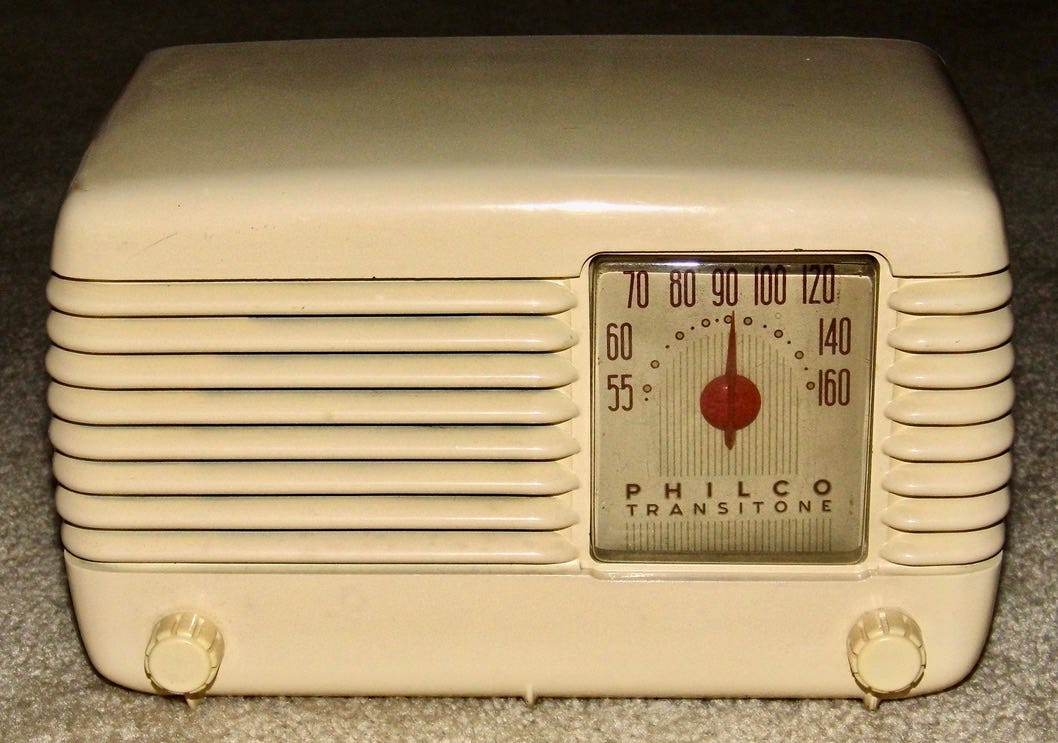Radio; Real Reality and Fictional Reality
AT HOME, in my parents’ house in Babbington Heights, in the corner of the attic that was my bedroom, I had, on a table beside my bed, a small Philco radio. It was made of cream-colored plastic. The radio had seen years of use on somebody else’s bedside table before I got it for my room.
Little Follies, “The Static of the Spheres”
This is not the small Philco radio that Peter Leroy had on a table beside his bed, though it could be. Nor is this the small Philco radio that Eric Kraft had on a table beside his bed, though it is nearly identical to it.
Terror, Induced by Fiction
This program so terrified me that I wanted to cry out for my own parents, to run downstairs for some comfort from them, at least to reassure myself that they were still there, but I couldn’t run to them because I was listening to the radio at a time of night when my mother didn’t allow me to listen, since the programs that were broadcast at those late hours were, she had told me often enough, the sort of thing that scared the wits out of young boys.
Little Follies, “The Static of the Spheres”
I think I know what may have “inspired” the radio program that Peter listens to in this chapter, because I know that the “Three Skeleton Key” episode of the radio series called “Escape” scared the wits out of Kraft when he heard it on his small Philco radio, listening under the bed covers at a time of night when he wasn’t allowed to listen, probably on the night of August 9, 1953, when he was eight-and-a-half.
According to the “Escape and Suspense” website:
The performance of this radio-play considered to be the best was one that Escape presented on March 17, 1950. They also performed this story on November 15, 1949, and August 9, 1953, but with different casts both times. Suspense brought back this radio-play with Vincent Price in the lead role on November 11, 1956, and October 19, 1958.
I doubt that Kraft heard the version broadcast on March 17, 1950, since he would have been only about five-and-a-half, but I’m offering that version to you because it is “considered to be the best.”
Of course, Kraft did not simply give Peter his experience. He made a new dish from it, changing some of the ingredients and spicing it differently, and in the process it was transformed; it became Peter’s.
No art without transformation.
Real Places, Fictional Places
Then Guppa bought a Motorola console radio as a Christmas gift for Gumma, and at once the Philco became a pedestrian radio. The Motorola had several bands, and it could pull in programs from places so far removed from Babbington that their names alone, printed at intervals along the dial, were enough to bring to mind notions of places so remote and exotic that I had to work to convince myself that they were real places, places where people worked, slept, ate meals, listened to radios, places that I could, someday, actually visit: Balbec, London, Macondo, Moscow, Paris, Tokyo.
Little Follies, “The Static of the Spheres”
Ignoring the Balbec in Indiana and the Macondo in Angola, only four of those places are “places that I could, someday, actually visit,” except, perhaps, by leaping:
I remember [Meyer] Schapiro telling us that before Cézanne, there had always been a place in landscape painting where the viewer could walk into the picture. There was an entrance; you could go there, like walking into a park. But this was not true of Cézanne’s landscapes, which were cut off absolutely, abstracted from their context. You could not walk into them—you could enter them only through art, by leaping.
[more to come on Wednesday, August 11, 2021]
Have you missed an episode or two or several?
You can catch up by visiting the archive.
At Apple Books you can download free eBooks of “My Mother Takes a Tumble,” “Do Clams Bite?” and “Life on the Bolotomy,” the first three novellas in Little Follies.





